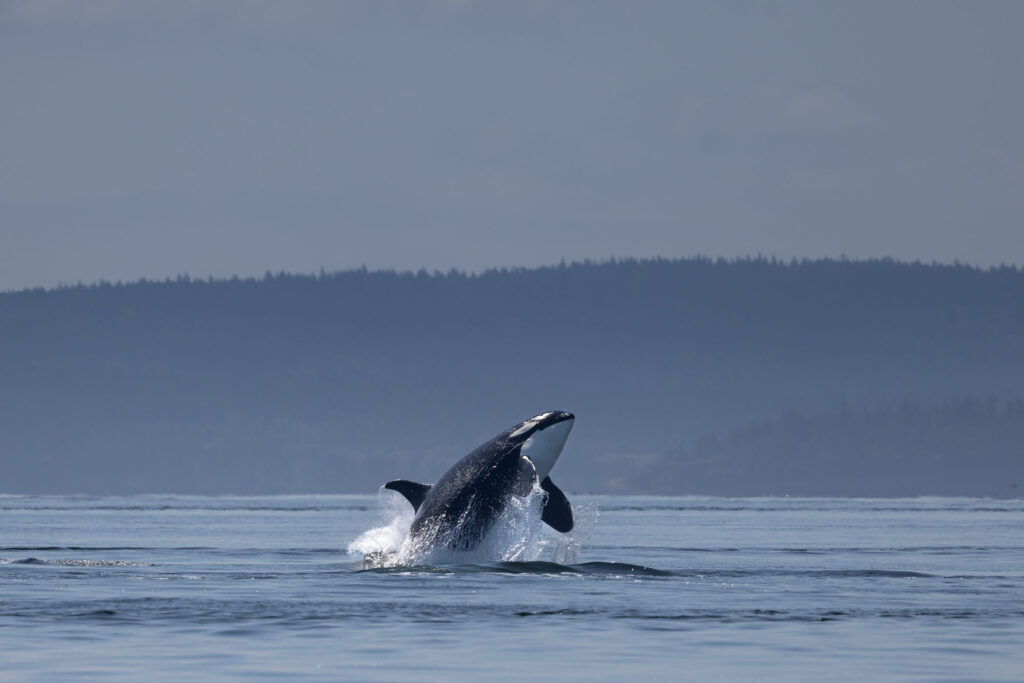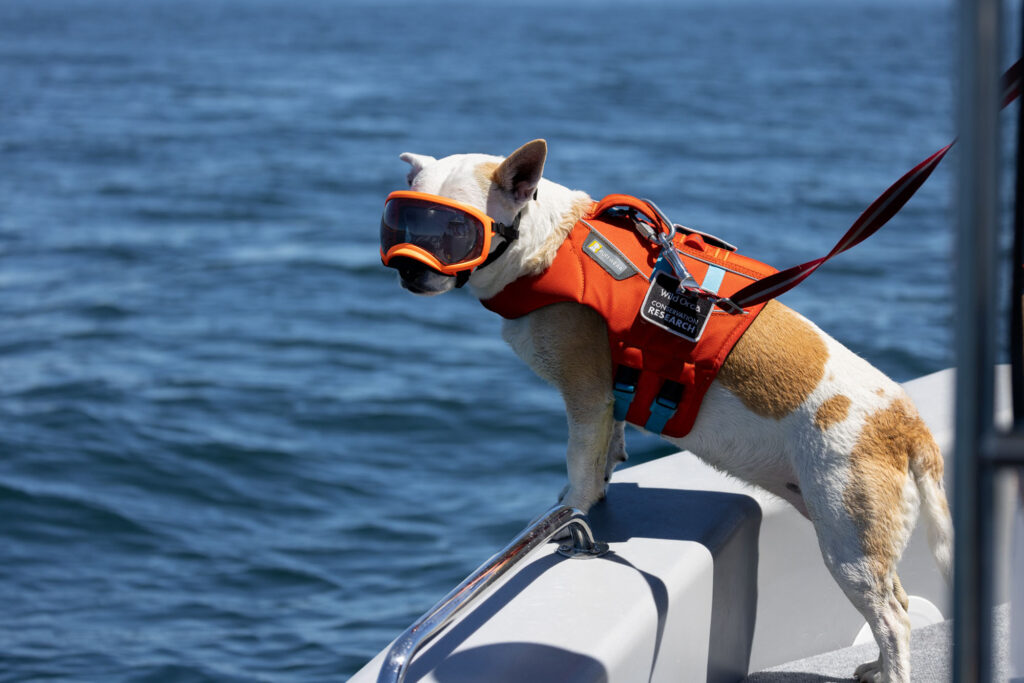
As the R/V Cheena cruises through the sapphire waters of the Salish Sea near San Juan Island on any given day, Eba—a 31-pound mixed breed rescue dog—can often be spotted perched on the vessel’s prow, her entire body leaning in earnest towards the waves. Her nose will be lifted high as she sweeps her snout back and forth, working from port to starboard, bow to stern, as she sniffs, sniffs, sniffs the air in search of a very particular scent: whale scat.
Her search is for science, as this specially trained, furry first mate works alongside her owner, Dr. Deborah Giles, to study the scat of the Southern Resident orca whale population in hopes of better understanding, and thus helping, the endangered species.
Giles, as she likes to be called, sits at the helm of Wild Orca, a Friday Harbor-based non-profit organization working to save the whales through a variety of avenues, starting with the conservation research that Eba helps out with on the water—and extending to strategic advocacy and policy engagement back on land.
“When it comes to our endangered Southern Residents, it’s not enough just to do science for science’s sake,” Giles says of the organization’s core mission. “We have to be asking questions, learning everything we can, and then translating those learnings into action.”
At Wild Orca, this means creating field reports that anyone, not just scientists, can understand; working with local legislators on protective measures for the whales; understanding why our whales are struggling and then making recommendations to the likes of NOAA, the Department of Fish & Wildlife, local legislators, or even the governor himself, as Giles has served on the official whale task force in the past.
Eba has been Giles’ trusted co-researcher for the past four years, but Giles’ mission to save the orcas dates back decades, stemming from an influential trip she took to the San Juan Islands at just 18 years old. Then living in Sacramento, California, she and her girlfriends traveled to the islands to go whale watching, and it was love at first sight for Giles.
“I saw them for the first time on my 18th birthday at Lime Kiln State Park,” she says, holding up a photo of herself sitting on the shoreline watching from shore as a whale breaches. “I just couldn’t get enough. I started making return trips whenever I could, and eventually even dropped everything to move up here and take an internship at the Whale Museum.”
In the ensuing years, Giles earned her masters and doctorate, and focused her thesis on how vessel presence and associated noise affects whales’ health and behavior. This subject led her to collecting data for NOAA and helping to develop a piece of equipment that could track the whale’s movements from a vessel, leading her to the work she does today with Eba.
The science of dog scent detection is not necessarily new, but one that has gained popularity in recent years because it is more non-invasive than other methods and allows scientists to track the whales from farther away, and thus, hopefully, decrease the whales’ stress levels. When it comes to whale scat detection specifically, the practice had been used by the University of Washington for many years under the leadership of Dr. Samuel Wasser, who piloted a program through the UW Center for Conservation Biology. Giles acted as a captain for a boat used in the program, and watched first-hand how the research dogs worked. After the program at UW ended due to a lack of funding, and the challenges posed by the Covid pandemic, Giles took up the mantle and the project was officially transferred to Wild Orca.
The trouble was, she didn’t have a research canine to help her, so she began to ponder a new possibility: Could her own companion dog be trained to help her?
“Honestly, it wasn’t something I’d ever thought about with Eba before that moment,” she says. “Not all dogs are suited for the work—some get seasick, or don’t have the right temperaments. The chances were slim that she could do it.”
The sweet pooch has her own interesting origin story, having been scooped off the streets of Sacramento as a puppy by Giles’ sister. She was emaciated, weighing in at only 3 pounds, and was nursed back to health. After a few years, the other dog living with Eba wasn’t tolerating the pup-now-turned-pooch, and Giles offered to take Eba to San Juan Island to live with her while she found her a new home. Giles and her husband had recently lost their beloved dog Cheena, for which their research vessel is now named, and she states she didn’t want another dog or another heartbreak. But Eba soon won her over, and the pair has been inseparable ever since.
So, perhaps it’s only fitting that this rescue dog turned out to be a natural at scent detection, having quickly picked up the training after just four days on land and two working at sea. Now, the canine is working to rescue a fellow creature from its own peril.
Eba can detect whale scat from up to a mile away, and gives both Giles and her husband, who pilots the boat, distinct signals when she picks up a scent. “We watch for a change in her behavior, she goes from relaxed to very stiff as we approach what we call the scent cone,” Giles explains. “We try to slowly zig zag back and forth within that scent area to try to locate the scat. She’ll crab walk on the side of the boat and move with the scent. It’s a stressful and exciting time, but if we do it right, she’ll let us know when we are almost right by it.” The scat can be tough to spot—ideally it’s the size of a dinner plate, but it can be as small as a thumbnail.
Once they collect samples, Giles can then study the scat to gather important data about how the whales are faring; everything from identifying hormones that would indicate pregnancy, nutritional stress, toxicant presence, to gleaning general overall health notes. These learnings help inform how Wild Orca goes about advocating for policy changes. For example, Giles points to the fact that research has indicated that the orcas are starving due to the scarcity of prey like salmon, so Wild Orca has used these data points to work with different government entities and legislators on methods to protect the prey fish. “As someone who is actively involved with the Southern Resident population and is on the front lines of what is happening out in the wild, we are in a unique position to recommend real change in real time.”
Giles and Eba recently appeared at the Seattle Boat Show and presented a seminar during the Dogs on Deck Day, just another example of how the organization is pushing information to as many parties as possible, including boaters. Giles states that, like her, boaters often encounter our whale population in person, and she encourages all to be educated on the most up-to-date rules and regulations set in place to keep the orcas safe. Also, she recommends boaters monitor the surroundings for whale activity, employ a laser range finder onboard, and alert other boaters by flying a Be Whale Wise flag.
“This is a highly endangered population of whales, in fact they are in the top ten of the most endangered, and we all have a role to play in their recovery,” she says. “Even a rescue dog found on the streets is playing a part. You certainly can too.”
Giles’ own role in the recovery is ongoing, as she is out studying the whales as much as possible, especially in the late spring and summer months, or whenever they make a surprise appearance. In fact, as we concluded our interview on a sunny day in March, Giles’ phone began buzzing with the news that J-Pod had been spotted just off the island. “I gotta go!” she said as she signed off with a huge, childlike grin on her face, leaping up to go off once again in search of the beloved Salish Sea behemoths, surely with her trusty sidekick Eba in tow.
>> For more information on Wild Orca—including field reports on their research projects, updates on policy initiatives, and the ways you can support protections for the Southern Residents—go to: wildorca.org



